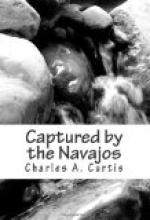This decision made the boys somewhat miserable for a time. They commiserated the dog over her misfortune, and then turned their attention to preparations for the journey.
“Have you ever been to La Paz?” asked Frank.
“I have never been beyond Date Creek in that direction,” I replied.
“Is the Xuacaxella really a desert?”
“Only in the rainless season. Grasses, cacti, and shrubbery not needing much moisture grow there. One of the geological surveys calls it Cactus Plain. It is one hundred miles long. There is water in a fissure of a mountain-spur on one side called the Cisternas Negras, or Black Tanks, but for the rest of the distance there was formerly no water except in depressions after a rainfall, a supply that quickly evaporated under a hot sun and in a dry atmosphere. A man named Tyson has lately sunk a well thirty miles this side of La Paz.”
“It was at Black Tanks the expressman saw Texas Dick and Juan Brincos with our ponies,” said Henry. “What a queer name that is!—Juan Brincos, John Jumper, or Jumping Jack, as nearly every one calls him.”
“He is well named; he has been jumping stock for some years.”
“I thought Western people always hanged horse-thieves?”
“Not when they steal from government. Western people are too apt to consider army mules and horses common property, and they suppose your ponies belong to Uncle Sam.”
“Frank,” said Henry, just before the boys fell asleep that night, “I felt almost sure we should recapture the ponies when I thought Vic was going, but now I’m afraid we never shall see them again.”
XII
INDIANS ON THE WAR-PATH
The following day we were so delayed by several minor affairs that we did not begin our journey until the middle of the afternoon.
At the time of which I write there were but two wagon-roads out of Prescott—one through Fort Whipple, which, several miles to the north, divided into a road to the west, the one over which we had marched from New Mexico, and a second which left in a northwesterly direction. We took the latter, pursuing it along the east side of Granite Range for eight miles, when we passed through a notch in the range to Mint Creek, where the road made an acute angle and followed a generally southwesterly course to La Paz.
We halted for the night at the creek, eight miles from the fort. Our ambulance was provided with four seats—one in front for the driver, fixed front and rear seats in the interior, with a movable middle seat, the back of which could be let down so that it fitted the interval between the others and afforded a fairly comfortable bed. On the rack behind were carried the mess chest, provisions, and bedding, and inside, under the seats, were the ammunition and some articles of personal baggage. Beneath the axle swung a ten-gallon keg and a nest of camp kettles.




